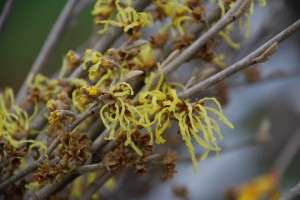First, not to confuse you, our North American native witchhazel (Hamamelis virginiana) blooms in the fall. Our native vernal witchhazel (H. vernalis) has been flowering for the past few weeks.
In February, the showiest witchhazels are opening now – species from China, Korea and Japan. Two of the very best are a Chinese species/cultivar called H. mollis ‘Wisley Supreme’ and a hybrid form called H. x intermedia ‘Westerstede’. Both are hardy in the Southern Appalachian region (USDA zones 6 and 7).
Let’s begin with Wisley Supreme. This vigorous shrub grows to 8 – 12 feet in height and 10 – 12 feet in width. A young shrub branches upright and with age takes on a spreading habit. Its pale yellow strap-like flowers are long lasting and sweetly scented. Spring-summer oval leaves exhibit a bluish green cast, turning buttery yellow in the fall.
Westerstede is a hybrid witchhazel from Germany (Japanese (H. japonicum) and Chinese (H. mollis). Westerstede bears light yellow 1- inch long ribbon-like flowers which are fragrant. Floral buds begin to open 1 – 2 weeks later than Wisley Supreme. The broad 5 – 6 inch circular green leaves turn buttery yellow in the fall.
While most hybrid witchhazels grow to tall 20 foot shrubs, the mature heights and widths of Westerstede and Wisley Supreme are similar. Westerstede summer foliage possesses better leaf spot resistant than the old-timey favorite ‘Arnold Promise’.
Witchhazels are easy to grow in an average well-drained moist garden soil. A slightly acidic pH soil is preferred. Annual spring pruning keep the vigorous witchhazels within their assigned garden spot.
Since most garden centers do not sell early blooming shrubs, witchhazels are easily purchased from the internet nursery market.


 Posted in
Posted in  Tags:
Tags: 
